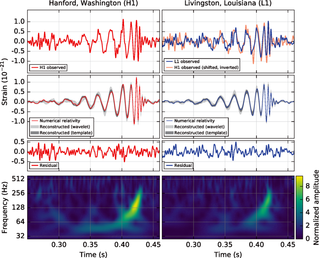When there exists at least one causal geodesic that, in the future, extends to an observer either at infinity or to an observer comoving with the collapsing cloud, and in the past terminates at the gravitational singularity, then that singularity is referred to as a naked singularity. In a black hole, the singularity is completely enclosed by a boundary known as the event horizon, inside which the curvature of spacetime caused by the singularity is so strong that light cannot escape. Hence, objects inside the event horizon—including the singularity itself—cannot be observed directly. A naked singularity, by contrast, would be observable from the outside.

The Laser Interferometer Space Antenna (LISA) is a proposed space probe to detect and accurately measure gravitational waves—tiny ripples in the fabric of spacetime—from astronomical sources. LISA would be the first dedicated space-based gravitational-wave observatory. It aims to measure gravitational waves directly by using laser interferometry. The LISA concept has a constellation of three spacecraft arranged in an equilateral triangle with sides 2.5 million kilometres long, flying along an Earth-like heliocentric orbit. The distance between the satellites is precisely monitored to detect a passing gravitational wave.

Gravitational collapse is the contraction of an astronomical object due to the influence of its own gravity, which tends to draw matter inward toward the center of gravity. Gravitational collapse is a fundamental mechanism for structure formation in the universe. Over time an initial, relatively smooth distribution of matter, after sufficient accretion, may collapse to form pockets of higher density, such as stars or black holes.
MiniGRAIL was a type of Resonant Mass Antenna, which is a massive sphere that used to detect gravitational waves. The MiniGRAIL was the first such detector to use a spherical design. It is located at Leiden University in the Netherlands. The project was managed by the Kamerlingh Onnes Laboratory. A team from the Department of Theoretical Physics of the University of Geneva, Switzerland, was also heavily involved. The project was terminated in 2005.
In general relativity, a geon is a nonsingular electromagnetic or gravitational wave which is held together in a confined region by the gravitational attraction of its own field energy. They were first investigated theoretically in 1955 by J. A. Wheeler, who coined the term as a contraction of "gravitational electromagnetic entity".

GEO600 is a gravitational wave detector located near Sarstedt, a town 20 km to the south of Hanover, Germany. It is designed and operated by scientists from the Max Planck Institute for Gravitational Physics, Max Planck Institute of Quantum Optics and the Leibniz Universität Hannover, along with University of Glasgow, University of Birmingham and Cardiff University in the United Kingdom, and is funded by the Max Planck Society and the Science and Technology Facilities Council (STFC). GEO600 is capable of detecting gravitational waves in the frequency range 50 Hz to 1.5 kHz, and is part of a worldwide network of gravitational wave detectors. This instrument, and its sister interferometric detectors, when operational, are some of the most sensitive gravitational wave detectors ever designed. They are designed to detect relative changes in distance of the order of 10−21, about the size of a single atom compared to the distance from the Sun to the Earth. Construction on the project began in 1995.

The Virgo interferometer is a large Michelson interferometer designed to detect gravitational waves predicted by general relativity. It is located in Santo Stefano a Macerata, near the city of Pisa, Italy. The instrument's two arms are three kilometres long, housing its mirrors and instrumentation inside an ultra-high vacuum.
Analog models of gravity are attempts to model various phenomena of general relativity using other physical systems such as acoustics in a moving fluid, superfluid helium, or Bose–Einstein condensate; gravity waves in water; and propagation of electromagnetic waves in a dielectric medium. These analogs serve to provide new ways of looking at problems, permit ideas from other realms of science to be applied, and may create opportunities for practical experiments within the analog that can be applied back to the source phenomena.

Gravitational-wave astronomy is an emerging field of science, concerning the observations of gravitational waves to collect relatively unique data and make inferences about objects such as neutron stars and black holes, events such as supernovae, and processes including those of the early universe shortly after the Big Bang.
The North American Nanohertz Observatory for Gravitational Waves (NANOGrav) is a consortium of astronomers who share a common goal of detecting gravitational waves via regular observations of an ensemble of millisecond pulsars using the Green Bank Telescope, Arecibo Observatory, and the Very Large Array. This project is being carried out in collaboration with international partners in the Parkes Pulsar Timing Array in Australia, the European Pulsar Timing Array, and the Indian Pulsar Timing Array as part of the International Pulsar Timing Array.
It was customary to represent black hole horizons via stationary solutions of field equations, i.e., solutions which admit a time-translational Killing vector field everywhere, not just in a small neighborhood of the black hole. While this simple idealization was natural as a starting point, it is overly restrictive. Physically, it should be sufficient to impose boundary conditions at the horizon which ensure only that the black hole itself is isolated. That is, it should suffice to demand only that the intrinsic geometry of the horizon be time independent, whereas the geometry outside may be dynamical and admit gravitational and other radiation.

In astrophysics, an extreme mass ratio inspiral (EMRI) is the orbit of a relatively light object around a much heavier object, that gradually spirals in due to the emission of gravitational waves. Such systems are likely to be found in the centers of galaxies, where stellar mass compact objects, such as stellar black holes and neutron stars, may be found orbiting a supermassive black hole. In the case of a black hole in orbit around another black hole this is an extreme mass ratio binary black hole. The term EMRI is sometimes used as a shorthand to denote the emitted gravitational waveform as well as the orbit itself.
The TianQin Project is a proposed space-borne gravitational-wave observatory consisting of three spacecraft in Earth orbit. The TianQin project is being led by Professor Luo Jun, President of Sun Yat-sen University, and is based in the university's Zhuhai campus. Construction on project-related infrastructure, which will include a research building, ultra-quiet cave laboratory, and observation center, began in March 2016. The project is estimated to cost 15 billion RMB, with a projected launch date in 2030s. In December 2019, China launched "Tianqin-1, its first satellite for space-based gravitational wave detection."
In statistics, Whittle likelihood is an approximation to the likelihood function of a stationary Gaussian time series. It is named after the mathematician and statistician Peter Whittle, who introduced it in his PhD thesis in 1951. It is commonly used in time series analysis and signal processing for parameter estimation and signal detection.
Romi Mankin is an Estonian physicist known for his work in the field of stochastic processes. Currently he holds a post in Tallinn University as a Professor of Theoretical Physics. He is well published having published many articles in both the Proceedings of the Estonian Academy of Sciences and in the various sections of Physical Review. and other major journals.
Marti J. Anderson is an ecological statistician whose works is interdisciplinary, from marine biology and ecology to mathematical and applied statistics. Her core areas of research and expertise are: community ecology, biodiversity, multivariate analysis, resampling methods, experimental designs, and statistical models of species abundances. Based in Auckland, New Zealand, she is a Distinguished Professor in the New Zealand Institute for Advanced Study at Massey University and also the Director of the New Zealand research and software-development company, PRIMER-e.
Siddhartha Chib is an econometrician and statistician, the Harry C. Hartkopf Professor of Econometrics and Statistics at Washington University in St. Louis. His work is primarily in Bayesian statistics, econometrics, and Markov chain Monte Carlo methods.
Jun Yu is an econometrician. He is the Lee Kong Chian Professor of Economics and Finance at the Singapore Management University. He has previously taught at University of Auckland.
Joan Robb was a New Zealand herpetologist and wildlife tour guide.

Lynnette Robin Ferguson is a New Zealand academic, and as of 2021 is an emeritus professor at the University of Auckland. Ferguson has been a Fellow of the Royal Society Te Apārangi since 2016.






